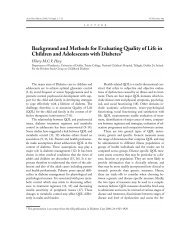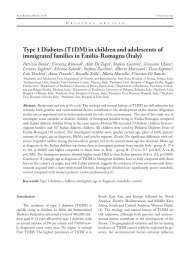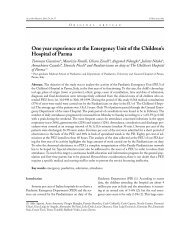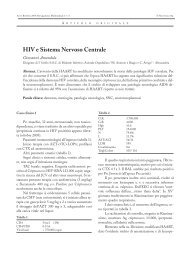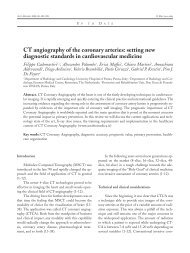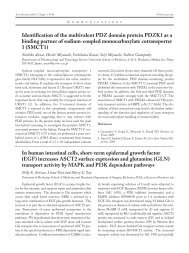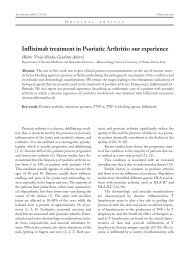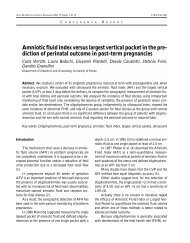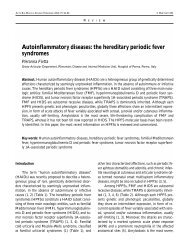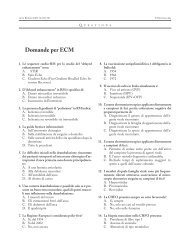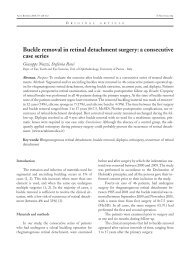Cefepime/clindamycin vs. ceftriaxone/clindamycin for the empiric ...
Cefepime/clindamycin vs. ceftriaxone/clindamycin for the empiric ...
Cefepime/clindamycin vs. ceftriaxone/clindamycin for the empiric ...
Create successful ePaper yourself
Turn your PDF publications into a flip-book with our unique Google optimized e-Paper software.
ACTA BIOMED 2008; 79: 117-122 © Mattioli 1885<br />
<strong>Cefepime</strong>/<strong>clindamycin</strong> <strong>vs</strong>. <strong>ceftriaxone</strong>/<strong>clindamycin</strong> <strong>for</strong> <strong>the</strong><br />
<strong>empiric</strong> treatment of poisoned patients with aspiration<br />
pneumonia<br />
Haleh Talaie 1 , Hamid Reza Jabari 2 , Shahin Shadnia 3 , Abdolkarim Pajouhmand 1 , Alejandro<br />
A. Nava-Ocampo 4,5 , Mehrnaz Youssefi 6<br />
1 Loghman-Hakim Hospital Poison Center, Toxicological Research Center, Shaheed Beheshti University of Medical Sciences,<br />
2 National Research Institute Tuberculosis and Lung Diseases, Shaheed Beheshti University of Medical Sciences, 3 Intensive<br />
Care Unit, Loghman Hakim Hospital Poison Center, 4 Di<strong>vs</strong>ion of Clinical Pharmacology & Toxicology, Hospital <strong>for</strong> Sick<br />
Children, Toronto, Canada; 5 Pharma Reasons, Toronto, Canada, 6 Bristol-Mayer Squibb, Tehran, Iran<br />
Abstract. Different antimicrobial treatments have proved to be effective in patients with aspiration pneumonia.<br />
However, resistant bacterial strains are commonly observed in hospital settings challenging <strong>the</strong> <strong>empiric</strong>al<br />
treatment of <strong>the</strong>se patients. In this study, we aimed to compare <strong>the</strong> efficacy of cefepime/<strong>clindamycin</strong><br />
and <strong>ceftriaxone</strong>/<strong>clindamycin</strong> <strong>for</strong> <strong>empiric</strong> <strong>the</strong>rapy of poisoned patients with aspiration pneumonia. In an<br />
open, randomized, prospective design, 140 consecutive patients aged more than 13 years, with radiographic<br />
signs of infiltration in chest radiography and dullness on percussion or pulmonary rales or ronchi in combination<br />
with at least two of <strong>the</strong> following clinical criteria were considered as eligible: fever ≥ 37 o C (axillary),<br />
or hypo<strong>the</strong>rmia < 35°C (axillary) and leukocytosis (> 10 cells/mm 3 ), or leukopenia (< 3,000 cells/mm 3 ), a leftshift<br />
of > 10%, or purulent sputum or secretion from trachea or bronchi. Participants received intravenously<br />
ei<strong>the</strong>r <strong>ceftriaxone</strong> 1 g q12 h and <strong>clindamycin</strong> 900 mg q8 h (group 1) or cefepime 1 g q12 h and <strong>clindamycin</strong><br />
900 mg q8 h (group 2). On day 5 of treatment, <strong>the</strong> number of improved/cured patients was not different between<br />
groups (OR 0.86; 95%CI 0.24 to 2.90) nor at 14 days of <strong>the</strong> study (OR 0.66; 95%CI 0.12 to 3.29).<br />
Six patients died in group 1 and 5 in group 2 (RR 0.83; 95%CI 0.28 to 2.46). In conclusion, efficacy of <strong>empiric</strong><br />
treatment of poisoned patients with aspiration pneumonia with <strong>ceftriaxone</strong>/<strong>clindamycin</strong> was comparable<br />
to treatment with cefepime/<strong>clindamycin</strong>. (www.actabiomedica.it)<br />
Key words: Antimicrobial agents, aspiration pneumonia, clinical research, disease management, randomized<br />
clinical trial<br />
Introduction<br />
Infective pneumonia following aspiration of infectious<br />
material from <strong>the</strong> oropharynx or stomach may<br />
result in life-threatening complications. Since many<br />
cases of community-acquired and nosocomial pneumonia<br />
may be due to unrecognized aspiration (1), <strong>the</strong><br />
true incidence of aspiration pneumonia is unknown.<br />
Reported prevalence data are extremely variable, ranging<br />
from 10% to 70%, and mortality is related to <strong>the</strong><br />
O R I G I N A L A R T I C L E<br />
volume and content of <strong>the</strong> aspirate and is reported to<br />
be as high as 70% (2). The anaerobic pathogens most<br />
frequently isolated from patients with aspiration<br />
pneumonia include Bacteroides, Peptostreptococcus, and<br />
Fusobacterium species (3). However, most patients<br />
with aspiration pneumonia have infection with multiple<br />
organisms and <strong>the</strong>re<strong>for</strong>e <strong>empiric</strong>al antimicrobial<br />
treatment is usually directed to cover both anaerobic<br />
and aerobic microorganisms. An antimicrobial regimen<br />
with <strong>clindamycin</strong>, ampicillin/sulbactam, and a
118 H. Talaie, H.R. Jabari, S. Shadnia, et al.<br />
cephalosporin was both well-tolerated and proved<br />
equally effective <strong>for</strong> treating patients with aspiration<br />
pneumonia and lung abscess than without a<br />
cephalosporin (4). Mono<strong>the</strong>rapy with cefepime 1 or 2<br />
g, usually administered intravenously two times daily,<br />
was as effective <strong>for</strong> clinical and bacteriological response<br />
as ceftazidime, <strong>ceftriaxone</strong> or cefotaxime<br />
mono<strong>the</strong>rapy (1 or 2 g two or three times daily) in a<br />
number of randomized, clinical trials in hospitalized<br />
adults and, less commonly, in pediatric patients with<br />
moderate to severe community-acquired or nosocomial<br />
pneumonia (5). However, resistant strains are always<br />
emerging and new <strong>the</strong>rapeutic alternatives are<br />
required. We <strong>the</strong>re<strong>for</strong>e aimed to compare a <strong>the</strong>rapeutic<br />
regimen with cefepime/<strong>clindamycin</strong> to ano<strong>the</strong>r<br />
with <strong>ceftriaxone</strong>/<strong>clindamycin</strong> <strong>for</strong> treating patients<br />
with aspiration pneumonia secondary to drug over-<br />
dose. This treatment protocol is selected according to<br />
our experience on predominant microorganisms in<br />
ICU of Loghman Hakim Hospital Poison Center.<br />
Methods<br />
Subjects<br />
The study was approved by <strong>the</strong> Ethics and Research<br />
Board of <strong>the</strong> National Research Institute Tuberculosis<br />
and Lung Diseases (Trial registration: No. 416),<br />
Shaheed Beheshti University of Medical Sciences, Iran.<br />
The study was designed as randomized and<br />
prospective clinical trial. Randomization was per<strong>for</strong>med<br />
by means of a pre-designed table of random<br />
numbers <strong>for</strong> 140 patients. The table of random num-<br />
Figure 1. Flow of patients through trial. The patients who died during <strong>the</strong> study were included in <strong>the</strong> analysis of mortality rates<br />
only
<strong>Cefepime</strong>/<strong>clindamycin</strong> <strong>vs</strong>. <strong>ceftriaxone</strong>/<strong>clindamycin</strong><br />
bers was designed by one of <strong>the</strong> investigators who did<br />
not participate enrolling <strong>the</strong> patients or allocating<br />
<strong>the</strong>m into <strong>the</strong> study groups.<br />
The sample consisted in patients with different<br />
drug overdose toxicity hospitalized in <strong>the</strong> intensive<br />
care unite at Loghman Hakim Hospital Poison Center(LHHPC).<br />
LHHPC is a unique referral center of<br />
poisoning in Tehran,Iran. This center estimated nearly<br />
20000 poisoned patients every year. Daily turn over<br />
in this center is 80-100 patients. Diagnosis of drug<br />
overdose toxicity per<strong>for</strong>med on <strong>the</strong> basis of a drug over<br />
dose history, and confirmed by clinical signs and<br />
symptoms , and also drug urine analysis [sometimes<br />
by urine analysis <strong>for</strong> TCA by thin layer chromatography<br />
(TLC) (Clark identification)]. Most of <strong>the</strong> patients<br />
had consciousness alterations in varying degrees<br />
and received mechanical ventilation within <strong>the</strong> first 48<br />
hours of post-admission to <strong>the</strong> hospital. Eligible patients<br />
were aged more than 13 years, and had infiltration<br />
in chest radiography and dullness on percussion<br />
or pulmonary rales or ronchi in combination with at<br />
least two of <strong>the</strong> following clinical criteria: fever<br />
≥ 37 o C (axillary), or hypo<strong>the</strong>rmia < 35°C (axillary) and<br />
leukocytosis (> 10 cells/mm 3 ), or left-shift (> 10%)<br />
leukopenia (< 3,000 cells/mm 3 ), or purulent sputum or<br />
secretion from trachea or bronchi. Sputum, pulmonary<br />
secretions and blood cultures were obtained<br />
be<strong>for</strong>e <strong>the</strong>rapy. The investigator who verified eligibility<br />
criteria and enrolled <strong>the</strong> patients did not participate<br />
in <strong>the</strong> design of <strong>the</strong> table of random numbers nor allocating<br />
<strong>the</strong> patients into <strong>the</strong> study groups.<br />
In group 1, participants received intravenous <strong>ceftriaxone</strong><br />
1 g q12 h plus <strong>clindamycin</strong> 900 mg q8 hours<br />
<strong>for</strong> seven to ten days duration whereas subjects in<br />
group 2 received intravenously cefepime 1 g q12 h<br />
plus <strong>clindamycin</strong> 900 mg q8 hours <strong>for</strong> five to seven<br />
days. The investigator who allocated <strong>the</strong> patients to<br />
<strong>the</strong> study groups did not participate in <strong>the</strong> design of<br />
<strong>the</strong> table of random numbers nor enrolling <strong>the</strong> patients<br />
into <strong>the</strong> study. Patients were evaluated clinically<br />
and by laboratory tests at baseline (day 0) and on days<br />
3 and 5 of admission as well as 1-2 weeks after <strong>the</strong> patient<br />
was discharged from <strong>the</strong> hospital.<br />
For purpose of <strong>the</strong> study, patients with poststenotic<br />
pneumonia, post-infarction pneumonia, sepsis,<br />
lung cancer or metastatic cancer, renal failure, se-<br />
119<br />
vere blood dyscrasia or those who had received antibiotic<br />
treatment within 24 h prior to <strong>the</strong>ir inclusion into<br />
<strong>the</strong> study were excluded. Pregnant or lactating<br />
women were also excluded.<br />
Study outcomes<br />
Mortality, improvement, and cure rates were<br />
evaluated as <strong>the</strong> main outcomes on days 5 and 14 after<br />
treatment. The criteria <strong>for</strong> improvement included<br />
decreasing trend of WBC and body temperature and<br />
normal breathing sound or partial resolution of radiography.<br />
The criteria <strong>for</strong> cure included partial or complete<br />
resolution of radiographic abnormalities to a<br />
range that was considered as acceptable and complete<br />
normalization of clinical signs (body temperature<br />
≤ 37 o C (axillary) and lung auscultation), laboratory<br />
parameters of infection (WBC count ≤ 10,000<br />
cells/mm 3 ) and partial resolution of radiographic abnormalities<br />
without new infiltrative changes were<br />
considered as cured. Adverse drug reactions occurring<br />
during <strong>the</strong> study period were also recorded.<br />
Data analysis<br />
The sample size was estimated assuming a comparison<br />
of two independent proportions in a ‘negative’<br />
trial (6), with an alpha error of 0.05, a 1-β of 0.95, a<br />
20% of maximum allowable difference, and a 90% as<br />
<strong>the</strong> proportion of respondents. These assumptions<br />
provided us with an estimated sample of a minimum<br />
of 50 cases in each treatment. A x 2 test was used <strong>for</strong><br />
comparing gender distribution and accumulated mortality<br />
rate between groups. A Student t test was used<br />
to test differences between groups in terms of patients’<br />
age (years) and blood pressure at discharge. The timecourse<br />
of body temperature and white blood cells was<br />
compared between groups by a two-way Analysis of<br />
Variance (ANOVA). The cure/improvement rate at 5<br />
days of treatment as well as <strong>the</strong> number of intubated<br />
subjects at days 5 and 14 of treatment were compared<br />
by means of Fisher’s exact test. Odds ratio (OR) were<br />
estimated, respectively. Statistical analyses were per<strong>for</strong>med<br />
by using <strong>the</strong> software StatsDirect v. 2.5.5<br />
(StatsDirect Ltd, Cheshire, United Kingdom), and<br />
<strong>the</strong> significant limit was p
120 H. Talaie, H.R. Jabari, S. Shadnia, et al.<br />
Results<br />
The two study groups, <strong>ceftriaxone</strong>/clyndamycin<br />
(n=70) and cefepime/clyndamycin (n=70) were comparable<br />
in terms of <strong>the</strong> number of male and female<br />
subjects, <strong>the</strong>ir age, and <strong>the</strong> number of cases intubated<br />
at <strong>the</strong> beginning of <strong>the</strong> study (Table 1). A positive microbiological<br />
blood culture was found in 13 (18.6%)<br />
and 12 (17.1%), respectively (P=0.8). Microbiological<br />
blood cultures were positive to Staphylococcus aureus<br />
coagulase + in 3 (4.3%) patients in <strong>the</strong> <strong>ceftriaxone</strong>/<br />
clyndamycin group and in 5 (7.1%) cases in cefepime/<br />
clyndamycin group (P = 0.49). Fur<strong>the</strong>rmore, a positive<br />
tracheal culture was observed in 27 (38.6%) and 29<br />
(41.4%), respectively (P = 0.7). A combination of<br />
Staphylococcus coagulase + and Klebsiella pneumoniae<br />
was found in 9 (12.9%) and 10 (14.3%), respectively<br />
(P = 0.8).<br />
We did not observe any statistical difference between<br />
<strong>ceftriaxone</strong>/<strong>clindamycin</strong> and cefepime/<strong>clindamycin</strong><br />
in <strong>the</strong> improvement/ cure rate (Table 1). In<br />
addition, whereas at <strong>the</strong> beginning of <strong>the</strong> study most<br />
patients in both groups were intubated and remained<br />
intubated after 5 days of treatment, all of <strong>the</strong>m had<br />
been extubated at day 14 and were being followed-up<br />
as outpatients.<br />
Table 1. Clinical data and clinical response to <strong>the</strong>rapy with ei<strong>the</strong>r <strong>ceftriaxone</strong>/clindamicin or cefepime/clindamicin<br />
Ceftriaxone (n = 70) <strong>Cefepime</strong> (n = 70) Statistical test P value<br />
Sex (M:F) 44:26 45:25 x2 test 0.86<br />
Age (yr.) [mean ± SD (ranges)] 31.5 ± 15.2 (13 – 95) 32.9 ± 14.5 (13-80) Student t test 0.58<br />
Intubated patients 67 (95.7) 66 (94.2) Fischer’s exact 0.72<br />
Drug abuser (addict to opium)<br />
Temperature (<br />
1(1.42%) 5(7.14%)<br />
oC) On admission 38.4 ± 0.6 38.2 ± 0.6 ANOVA 0.0005; between<br />
evaluation times<br />
Day 3 38.0 ± 0.6 37.7 ± 0.6 0.0001; between<br />
treatments<br />
Day 5<br />
White blood cells (/mm<br />
37.7 ± 0.5 37.4 ± 0.7 0.003; <strong>for</strong> interaction<br />
3 )<br />
On admission 12,971.0 ± 5,080.1 13,888.0 ± 4,971.2 ANOVA
<strong>Cefepime</strong>/<strong>clindamycin</strong> <strong>vs</strong>. <strong>ceftriaxone</strong>/<strong>clindamycin</strong><br />
In relation to <strong>the</strong> clinical response, although differences<br />
in <strong>the</strong> patients’ body temperature at <strong>the</strong> different<br />
evaluation times and between treatment groups were<br />
statistically significant (P = 0.0005 and 0.0001, respectively),<br />
<strong>the</strong>y were clinically irrelevant, i.e. 1 o C in average<br />
(Table 1). The number of improved/cured patients was<br />
not different between groups at 5 days of treatment<br />
(OR 1.16; 95%CI 0.38 to 3.55) or at 14 days of <strong>the</strong><br />
study (OR 1.50; 95%CI 0.36 to 6.56). The relative risk<br />
of mortality was also not different between groups (OR<br />
1.40; 95%CI 0.39 to 5.21). Finally, no differences were<br />
noticed between treatments in terms of white blood<br />
cells and blood pressure, and no patient showed any evidence<br />
of drug adverse reaction or drug toxicity.<br />
Discussion<br />
Antimicrobial <strong>the</strong>rapy against anaerobic microorganism<br />
is a cornerstone <strong>for</strong> treating patients with aspiration<br />
pneumonia. In our study, <strong>ceftriaxone</strong>/ <strong>clindamycin</strong><br />
and cefepime/<strong>clindamycin</strong> were comparable<br />
in terms of efficacy and safety <strong>for</strong> treating patients<br />
with aspiration pneumonia in an overdose population<br />
of patients. Beside <strong>the</strong> distinction between aspiration<br />
pneumonitis (acute lung injury occurring after inhalation<br />
of regurgitated gastric content) and aspiration<br />
pneumonia (developed after inhalation of colonized<br />
oropharyngeal material) (1), in our study, we observed<br />
a mortality rate of 7.9% (n= 11/140) which is comparable<br />
to <strong>the</strong> 8.5% reported among overdosed cases<br />
who had aspiration pneumonitis (7). There<strong>for</strong>e, overdosed<br />
patients with ei<strong>the</strong>r aspiration pneumonitis or<br />
aspiration pneumonia should be considered at a high<br />
risk of progressing to severe complications and death.<br />
A recent study investigating <strong>the</strong> penetration of<br />
cefuroxime, cefamandole, <strong>ceftriaxone</strong>, ceftazidime and<br />
cefepime into <strong>the</strong> sputum reported that only <strong>ceftriaxone</strong><br />
had a measurable concentration in <strong>the</strong> sputum (8).<br />
In contrast, in four trials including more than 200<br />
children with lower respiratory tract infections, cefepime<br />
was shown to be as effective, safe and well-tolerated<br />
than ceftazidime, cefotaxime or cefuroxime (9).<br />
In addition, cefepime and <strong>ceftriaxone</strong> were comparable<br />
in safety and efficacy <strong>for</strong> <strong>the</strong> treatment of adult patients<br />
with community acquired pneumonia (10). It is<br />
121<br />
<strong>the</strong>re<strong>for</strong>e probably that drug penetration into sputum<br />
cannot be a proper surrogated marker of clinical efficacy<br />
of antimicrobials when treating patients with aspiration<br />
pneumonia.<br />
Since <strong>clindamycin</strong> lacks of activity against Gramnegative<br />
bacteria, its co-administration with a secondor<br />
third-generation cephalosporin has proved to be effective<br />
when treating patients with aspiration pneumonia<br />
(4). In our study, <strong>the</strong> evaluated treatment consisted<br />
of a combination of <strong>clindamycin</strong> and a third- or<br />
a fourth-generation cephalosporin (<strong>ceftriaxone</strong> and<br />
cefepime, respectively). The two antimicrobial combinations<br />
were similar in terms of efficacy and tolerance.<br />
Different <strong>the</strong>rapeutic regimens have been reported<br />
in <strong>the</strong> literature <strong>for</strong> treating patients with aspiration<br />
pneumonia including mono<strong>the</strong>rapy with cefepime or<br />
<strong>ceftriaxone</strong> (5,9), ampicillin and sulbactam (4), <strong>clindamycin</strong><br />
and a second or third-generation cephalosporin<br />
(4), and a combination of <strong>clindamycin</strong> with a<br />
fourth-generation cephalosporin (present study). In all<br />
of <strong>the</strong>se studies, a good efficacy and tolerability in addition<br />
to a lack of statistical differences between <strong>the</strong> compared<br />
groups, was reported. In adherence to <strong>the</strong> proposal<br />
by Wunderink several years ago (11), we consider<br />
that <strong>the</strong>re is a need <strong>for</strong> designing cost-effectiveness<br />
analysis in future studies in order to clarify <strong>the</strong> best<br />
<strong>the</strong>rapeutic alternative under different perspectives and<br />
not only regarding <strong>the</strong>ir anticipated good efficacy.<br />
Conclusion<br />
Efficacy of <strong>empiric</strong> treatment of poisoned patients<br />
with aspiration pneumonia with <strong>ceftriaxone</strong>/<br />
<strong>clindamycin</strong> was comparable to cefepime/<strong>clindamycin</strong>.<br />
Although we didn’t have significant statistical analysis<br />
in comparison by <strong>the</strong>se two regimens, but according to<br />
<strong>the</strong> duration of treatment, more studies are needed to<br />
clarify <strong>the</strong> cost-effectives of <strong>the</strong>se <strong>the</strong>rapies.<br />
Acknowledgements<br />
In Tehran, Iran, <strong>the</strong> study was supported by a grant from<br />
<strong>the</strong> National Research Institute Tuberculosis and Lung Diseases,<br />
and Bristol-Myers Squibb (BMS). Participation of<br />
AAN-O was without any economic or o<strong>the</strong>r type of relationship<br />
with BMS.
122 H. Talaie, H.R. Jabari, S. Shadnia, et al.<br />
References<br />
1. Marik PE. Aspiration pneumonitis and aspiration pneumonia.<br />
N Engl J Med 2001; 344: 665-71.<br />
2. DeLegge MH. Aspiration pneumonia: incidence, mortality,<br />
and at-risk populations. J Parenter Enteral Nutr 2002; 26<br />
Suppl 6: S19-24.<br />
3. Johnson JL, Hirsch CS. Aspiration pneumonia. Recognizing<br />
and managing a potentially growing disorder. Postgrad Med<br />
2003; 113: 99-102<br />
4. Allewelt M, Schuler P, Bolcskei PL, et al. Study Group on<br />
Aspiration Pneumonia. Ampicillin + sulbactam <strong>vs</strong> <strong>clindamycin</strong><br />
+/- cephalosporin <strong>for</strong> <strong>the</strong> treatment of aspiration pneumonia<br />
and primary lung abscess. Clin Microbiol Infect 2004;<br />
10: 163-70.<br />
5. Chapman TM, Perry CM. <strong>Cefepime</strong>: a review of its use in<br />
<strong>the</strong> management of hospitalized patients with pneumonia.<br />
Am J Respir Med 2003; 2: 75-107.<br />
6. Tai BC, Lee J. Sample size and power calculations <strong>for</strong> comparing<br />
two independent proportions in a “negative” trial.<br />
Psychiatry Res 1998; 80: 197-200.<br />
7. Isbister GK, Downes F, Sibbritt D, et al. Aspiration pneu-<br />
monitis in an overdose population: frequency, predictors,<br />
and outcomes. Crit Care Med 2004; 32: 88-93.<br />
8. Klekner A, Bagyi K, Bognar L, et al. Effectiveness of<br />
cephalosporins in <strong>the</strong> sputum of patients with nosocomial<br />
bronchopneumonia. J Clin Microbiol 2006; 44: 3418-21.<br />
9. Bradley JS, Arrieta A. Empiric use of cefepime in <strong>the</strong> treatment<br />
of lower respiratory tract infections in children. Pediatr<br />
Infect Dis J 2001; 20: 343-9.<br />
10. Zervos M, Nelson M; The <strong>Cefepime</strong> Study Group. <strong>Cefepime</strong><br />
versus <strong>ceftriaxone</strong> <strong>for</strong> <strong>empiric</strong> treatment of hospitalized<br />
patients with community-acquired pneumonia. Antimicrob<br />
Agents Chemo<strong>the</strong>r 1998; 42: 729-33.<br />
11. Wunderink RG. Pharmacoeconomics of pneumonia. Am J<br />
Surg 2000; 179 Suppl 2: 51S-57S.<br />
Accepted: 4th July 2008<br />
Correspondence: Haleh Talaie, MD<br />
Toxicological Research Center<br />
South Karegar Ave., Kamali Street<br />
Postal code 1333631151<br />
Tehran, Iran<br />
Fax + 98 21 55409534<br />
E-mail: talaeih@yahoo.com; ww.actabiomedica.it



